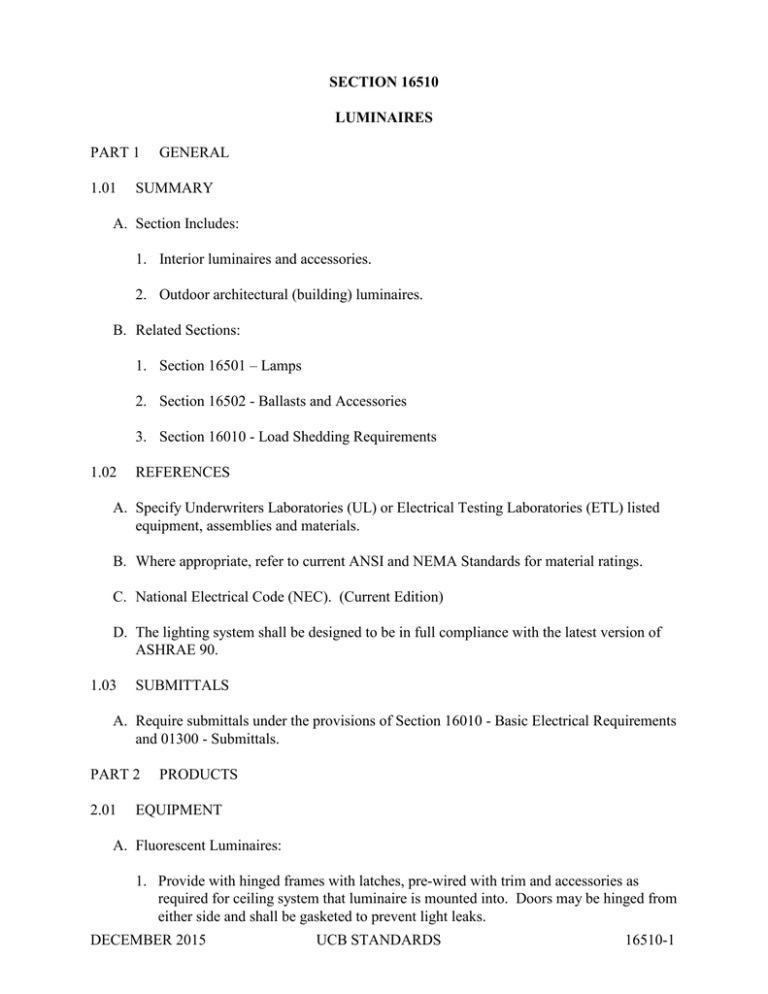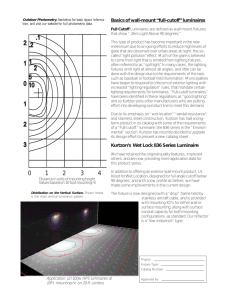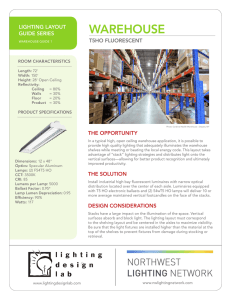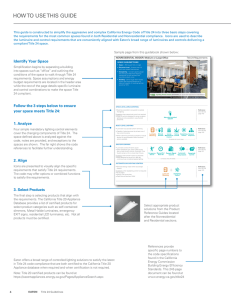Luminaires - University of Colorado Boulder
advertisement

SECTION 16510 LUMINAIRES PART 1 1.01 GENERAL SUMMARY A. Section Includes: 1. Interior luminaires and accessories. 2. Outdoor architectural (building) luminaires. B. Related Sections: 1. Section 16501 – Lamps 2. Section 16502 - Ballasts and Accessories 3. Section 16010 - Load Shedding Requirements 1.02 REFERENCES A. Specify Underwriters Laboratories (UL) or Electrical Testing Laboratories (ETL) listed equipment, assemblies and materials. B. Where appropriate, refer to current ANSI and NEMA Standards for material ratings. C. National Electrical Code (NEC). (Current Edition) D. The lighting system shall be designed to be in full compliance with the latest version of ASHRAE 90. 1.03 SUBMITTALS A. Require submittals under the provisions of Section 16010 - Basic Electrical Requirements and 01300 - Submittals. PART 2 2.01 PRODUCTS EQUIPMENT A. Fluorescent Luminaires: 1. Provide with hinged frames with latches, pre-wired with trim and accessories as required for ceiling system that luminaire is mounted into. Doors may be hinged from either side and shall be gasketed to prevent light leaks. DECEMBER 2015 UCB STANDARDS 16510-1 2. Recessed fluorescent fixtures to be equipped with 6’ long flexible whip for connection to a junction box. 3. AU fixtures should be connected to a junction box. Daisy chain of fixtures is not permitted. 4. Acrylic lenses shall have a minimum 0.125 inch thickness. B. Incandescent Luminaires (may only be used with University written approval): 1. Pre-wired with lens and reflector retainer clips and mounting accessories. 2. Recessed fixtures to be equipped with thermal protection and labeled per NEC as thermally protected. C. Exit Signs: 1. Light emitting diode (LED), low wattage type with long life, maintenance free battery require programmed discharge under load, self-testing and self-diagnostics. Green letters on white background. When used in a building with an emergency generator, batteries are not required. 2. Accepted Manufacturers: a. Exitronics, 500 Series b. Others only by approval by University D. Egress/Emergency Lights. Self-testing (the unit shall perform battery tests in accordance with NFPA), self-diagnostic (the unit shall perform self diagnostics and indicate problems discovered via LED’s.) 1. Dual Light Spectron 2. Prescolite CVS 3. Siltron Continuous Diagnostic 4. Others by approval of University E. HID Luminaires: 1. Pre-wired with integral ballast. Where required by lamp failure, provide with protective lens to retain lamp particles in the event of non-passive lamp failure. 2. Provide, where necessary, tungsten halogen lamp for instant light in the event of a momentary power outage. DECEMBER 2015 UCB STANDARDS 16510-2 2.02 LIGHTING CONTROL A. In all new buildings and all major renovations projects, the project shall install a lighting control system. This lighting control system shall work in harmony with the lighting load shed system and shall be controlled by the campus Andover system. B. Function: 1. This system shall provide a method to uniformly turn the lights on and off in the space. 2. All fixtures with more than two lamps shall also be tied to the load shed system. 3. The lighting control system shall provide the ability of sweeping the lights off and allowing them to be turned on. There shall be a minimum five minute warning before the lights are swept off 4. Local control shall be provided in all spaces which shall temporarily override the sweep off for a predetermined period of time. C. Installation: 1. The lighting control system shall include lighting control panels, relay, and control devices. 2. CAT-5e or similar low voltage communication cable shall be yellow and black striped to avoid confusion with other building communication and data systems. D. Design and cost: 1. Optional features the team may consider are daylight harvesting, occupancy sensors, scheduling of the lights, providing local access to temporarily override schedules. 2. As a measure to track costs the design team shall require, obtain a breakdown of Andover cost to control this system. 3. A standalone system shall also be priced. PART 3 3.01 EXECUTION INSTALLATION A. Require independent support systems for all fixtures except for light weight incandescent fixtures. All luminaires shall hang evenly and in straight rows. B. Support incandescent fixtures independently from the structural ceiling. C. Outlet boxes which support lighting fixtures shall be required to have support from the building structure independent of conduit system and ceiling systems. D. Require that fluorescent fixtures be supported independently from the structural ceiling. E. Use highest available standard voltage for luminaire circuitry. However, give consideration to ease of switching in small areas where fluorescent and incandescent are used together. DECEMBER 2015 UCB STANDARDS 16510-3 F. Use fluorescent and HID luminaires whenever possible. The use of incandescent fixtures is prohibited unless written University authorization is given. G. All 3 and 4 lamp luminaires shall be dual switched. Connect one set of switched lamps to the emergency load shed system described in 16010. Luminaire may be master-started. H. All interior recessed HID, and compact fluorescent luminaires shall have all wiring and ballasts be accessible through the ceiling luminaire opening. The angle of maximum candela from each interior fixture shall intersect opaque building interior surfaces and not exit building through windows 3.02 LUMINAIRE AND DESIGN APPLICATIONS A. Classrooms/Auditoria 1. General Classroom and auditorium lighting shall be provided by 4’ fluorescent luminaires where ever possible. The designer may use any luminaire the project can afford as long as its use and design is justifiable. No acrylic or other plastic lenses. Use dual level, 3-way and/or front-back zone switching. When used we recommend the use of wall wash systems to create visual interest. 2. Chalkboard lighting shall be provided in all classrooms. Luminaires to match general lighting luminaires as closely as possible and be located with respect to the chalkboard(s) so as to provide proper vertical illuminance, with no veiling reflections or direct glare. Separate switching to be provided for chalkboard(s). 3. The use of incandescent lighting in classrooms is prohibited. When incandescent must be used, tungsten-halogen sources shall be used. Minimum illuminance levels should be maintained. Incandescents will only be allowed in dimming applications and only in those cases where dimming fluorescent luminaries can not be tolerated and written permission from the University is obtained. B. Offices 1. General office lighting shall be provided by 4’ fluorescent luminaires. No acrylic or other plastic lenses. Use dual level, 3-way and/or zone switching. When used we recommend the use of wall wash systems to create visual interest. 2. Task lighting at desks is strongly encouraged and should be used where possible. C. Indirect/Direct Lighting 1. The use of indirect/direct lighting systems is strongly encouraged and should be used whenever possible and affordable. Do not use these systems in areas with lower that 9’ ceiling. The use of this type of lighting system may have an impact on the design lighting levels. DECEMBER 2015 UCB STANDARDS 16510-4 D. Compact Fluorescent Downlights 1. Compact fluorescent downlights should be used as accent lights only. They should not be solely used to light any space without written permission from CU. 3.03 INTERIOR ILLUMINATION LEVELS A. Design to the recommended minimum illumination levels for the type of areas indicated. Illumination levels are not necessarily average levels over an entire space. Task oriented lighting is encouraged where its use will not affect general appearance of space adversely. For all areas, refer to the most current issue of the IES Lighting Handbook for illumination levels. All levels indicated are maintained illumination levels. Illumination levels are not necessarily average levels over an entire space. Task oriented lighting is encouraged where its use will not affect general appearance of space adversely. All levels indicated are maintained illumination levels. 3.04 LUMINAIRE SCHEDULE A. Provide a luminaire schedule on the documents to give the following information: 1. Luminaire identification 2. Description 3. Manufacturer and catalog number 4. Voltage 5. Lamps (number and type) 6. Mounting with required recess depth 7. Mounting height 8. Two alternate manufacturers 9. Watts per fixture END OF SECTION 16510 DECEMBER 2015 UCB STANDARDS 16510-5


